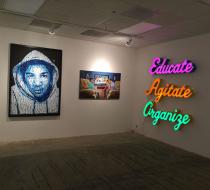Manifest Justice Favorite
Last August, as protesters marched in Ferguson, Missouri, after the death of Michael Brown, the 18-year-old unarmed teen shot by a police officer, another group of activists began thinking about how to incorporate the creative community into the movement. The result is Manifest:Justice, a free pop-up art show taking place in Los Angeles.
“The idea is that art is at the center of social change—and social change is about more than the civil rights movement,” says Nijeul Porter, the community outreach and program coordinator of Manifest:Justice. To that end, show organizers commissioned more than 250 pieces around the theme of social justice and its intersection with issues such as health, racial justice, human rights, education, LGBT rights, and capital punishment.
The drawings, paintings, protest posters, and three-dimensional works on display are focused on one goal: inspiring people to take back their communities, challenge institutional biases and inequalities, and identify solutions.
“A lot of these artists really went in—they are really challenging the audience to think critically about what is happening around issues of justice in this country,” says Porter.
Much of the provocative art on display tackles the problem of police brutality. A poignant painting called The Talk depicts how black parents have to sit their sons down and tell them how to avoid being killed by law enforcement. Then there's a drawing of Oscar Grant, posters with lyrics of the classic KRS-One song "Sound of Da Police," a vehicle constructed from parts of police cars, and a sculpture of a pack of cigarettes that references the death at the hands of police of Staten Island resident Eric Garner last summer. Garner was placed in a choke hold after being stopped by the police for selling “loosies”—individual cigarettes.
“We partnered with local groups in many ways, such as with the Community Coalition, a local social and economic justice nonprofit, which took photos of people wearing hoodies after Trayvon Martin’s death and turned them into a collage image of Martin,” says Porter. Youth docents, who will guide visitors through the show, were trained with the help of the California African-American Museum. While internationally recognized artists such as Shepard Fairey have pieces on display, several of the works are from up-and-coming artists who reside in South Los Angeles and have firsthand knowledge of the problems that communities of color experience.






